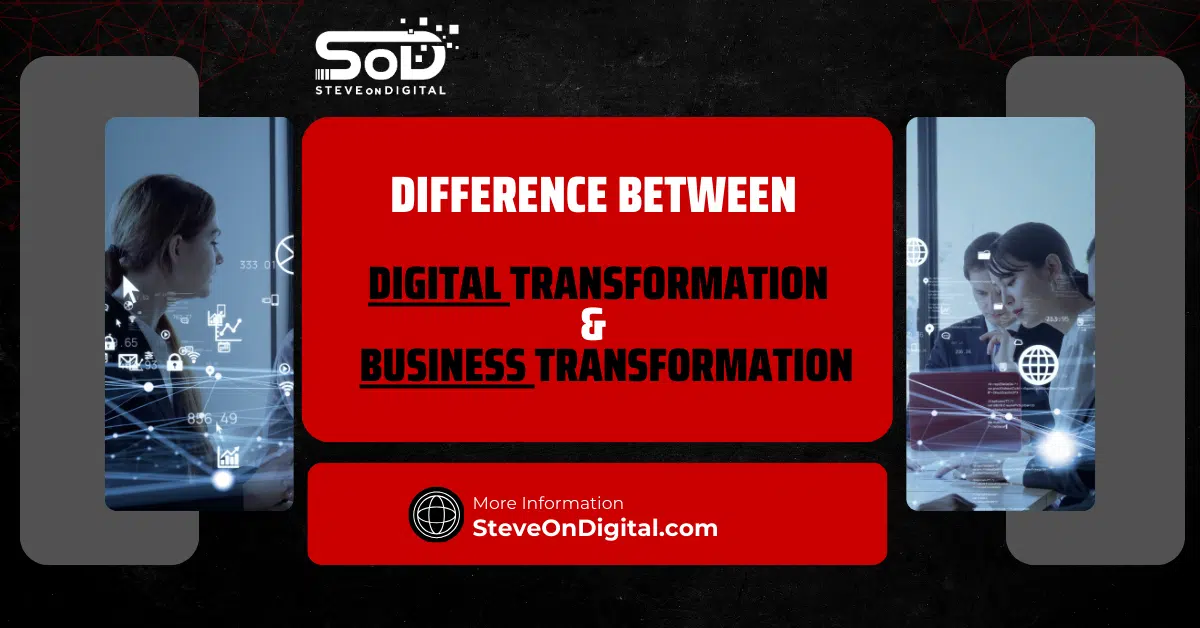As Steve Johnston, the heart and soul behind SteveOnDigital, I’ve journeyed through the digital transformation landscape, not just as a bystander but as a participant, guiding small and medium-sized enterprises (SMEs) toward realizing their digital potential.
Today, I want to shed light on a topic close to my heart: the benefits of digital transformation for small businesses.
This isn’t just another buzzword; it’s a pivotal shift that can redefine the future of businesses willing to embrace change.
Digital transformation is about bringing digital tech into every corner of a business.
It changes the way you work and how you offer value to your customers.
It’s about more than just upgrading your IT infrastructure; it’s a reimagining of business in the digital age.
For small businesses, this transformation isn’t just beneficial; it’s crucial for survival and growth in today’s fast-paced, technology-driven market.
By incorporating digital tools and technologies, small businesses can unlock a treasure trove of opportunities, from streamlining operations to enhancing customer experiences.
But more importantly, it paves the way for sustainable growth and a competitive edge that can set your business apart.
As we delve deeper, let’s explore what digital transformation really means for small businesses and how it can turn challenges into opportunities for growth.
Understanding Digital Transformation
What Is Digital Transformation?
In the simplest terms, digital transformation for small businesses means adopting digital technologies to improve processes, enhance customer experiences, and adapt to changing market dynamics.
It’s not just about having a website or using social media; it’s about leveraging technology to make every aspect of your business more efficient, agile, and customer-focused.
From my experience, I’ve seen firsthand how small businesses can benefit from this shift.
By integrating digital solutions, from cloud computing to customer relationship management (CRM) systems, businesses can achieve remarkable improvements in operational efficiency and customer satisfaction.
It’s not just a step towards digitization; it’s a leap towards future-proofing your business.
The Role Of Digital Tools And Technologies
Digital tools and technologies are the building blocks of digital transformation.
They range from simple applications that automate mundane tasks to sophisticated data analytics platforms that provide insights into customer behavior.
For small businesses, the adoption of these tools can be a game-changer.
Digital Tools:
- Cloud-Based Solutions: Cloud computing has democratized access to powerful IT infrastructure, allowing small businesses to scale resources up or down based on demand, ensuring flexibility and cost efficiency.
- Digital Marketing: Leveraging digital channels to promote your products or services can help you reach a broader audience more effectively than traditional marketing methods.
- Software Management Solutions: Tools that manage customer information, inventory, and financial records can streamline operations and reduce manual errors. Additionally, these solutions enable small businesses to access business-critical data, enhancing decision-making and operational efficiency.
Digital Technologies:
- Data Analytics: Analyzing customer data helps in understanding market trends and customer preferences, enabling businesses to make informed decisions.
- Artificial Intelligence and Machine Learning: These cutting-edge technologies can automate customer service, personalize marketing efforts, and predict market changes, giving small businesses an edge over competitors.
- Digital Platforms: Platforms like e-commerce websites and mobile apps provide businesses with new channels to reach customers, sell products, and build brand loyalty.
In my journey with SteveOnDigital, I’ve embraced these tools and technologies, not just as recommendations for others but as integral parts of my own business strategy.
For instance, adopting a software management solution for customer data has enabled me to deliver personalized content and courses to my audience, significantly enhancing customer engagement and satisfaction.
Moreover, my active use of data analytics has been instrumental in understanding the needs and behaviors of my audience.
This not only informs my content strategy but also allows me to adjust my digital marketing efforts for maximum impact.
The result? A stronger connection with my community and sustainable growth for SteveOnDigital.
Core Benefits Of Digital Transformation
Embarking on a digital transformation journey can be a game-changer for small businesses, especially those like ours at SteveOnDigital, by unlocking a myriad of digital transformation benefits.
Here, I’ll dive into how this pivotal shift not only enhances operational efficiency digital transformation and customer experience but also opens up new markets and revenue streams.
Digital transformation enables future digital growth, setting the stage for long-term success and innovation.
Enhanced Operational Efficiency
One of the most immediate benefits of digital transformation is the significant boost in operational efficiency.
By integrating digital processes and cloud-based solutions, small businesses can streamline their operations, reducing the time and resources spent on manual tasks.
- Digital Processes: Utilizing software solutions for inventory management, customer relationship management (CRM), and financial operations can automate many of the day-to-day tasks that previously required manual input. This shift not only saves time but also increases accuracy, reducing the chance of human error.
- Cloud-Based Solutions: Cloud computing offers small businesses the flexibility to use and pay for only the computing resources they need, scaling up or down as necessary. This adaptability ensures that small businesses can manage their resources more efficiently, avoiding the overhead costs associated with maintaining physical servers and infrastructure.
In my experience, automating repetitive tasks such as customer inquiries and billing has freed up our team’s time to focus on strategic initiatives and innovation.
It’s not just about doing things faster; it’s about doing them smarter, allowing us to deliver more value to our clients in less time.
Improved Customer Experience
The heart of digital transformation lies in its ability to enhance how we connect with and serve our customers.
By harnessing the power of data analytics to analyze customer data, small businesses can gain invaluable insights into customer behaviors and preferences, enabling them to deliver more personalized, high-quality user experiences.
- Analyzing Customer Data: Tools that offer insights into customer interactions can help businesses understand what their customers want and expect. This understanding allows for more targeted and effective marketing strategies, product development, and customer service initiatives.
- Meeting and Exceeding Customer Expectations: Today’s customers expect seamless, personalized experiences across all channels. Digital transformation enables businesses to meet these expectations by providing consistent, high-quality interactions, whether online or offline, thereby enhancing customer satisfaction and loyalty.
At SteveOnDigital, leveraging customer data has enabled us to tailor our digital content and offerings to better meet the needs of our audience.
By understanding what our users find valuable, we’ve been able to enhance user satisfaction significantly, turning casual visitors into loyal followers.
Access To New Markets And Revenue Streams
Digital transformation doesn’t just improve what we’re already doing; it opens up entirely new opportunities for growth and expansion.
Through digital platforms and marketing strategies, small businesses can reach new audiences and explore innovative business models.
- Digital Platforms: E-commerce websites, mobile apps, and social media channels allow small businesses to reach beyond their local markets, accessing customers worldwide. This global reach was once only possible for large corporations but is now within grasp for even the smallest of businesses.
- Cutting-edge Technology: The use of AI and machine learning not only enhances customer engagement through personalized experiences but also provides businesses with insights into emerging market trends. This technology enables small businesses to anticipate changes in customer behavior and adapt quickly, staying one step ahead of the competition.
Incorporating AI into our digital strategy at SteveOnDigital has been transformative.
By automating customer segmentation and personalizing content recommendations, we’ve been able to engage with our audience more effectively, leading to higher conversion rates and uncovering new revenue opportunities.
Comparison Of Pre And Post-Digital Transformation
| Aspect | Pre-Digital Transformation | Post-Digital Transformation |
| Operational Efficiency | Manual tasks dominate, leading to higher time and resource consumption. | Automation of repetitive tasks reduces time and resources spent. |
| Customer Experience | Limited personalization leading to generic customer interactions. | Enhanced personalization through data analytics improves satisfaction. |
| Market Access | Primarily local, with limited outreach. | Global reach through digital platforms and marketing strategies. |
Digital Transformation Strategies For Small Businesses
As we venture deeper into the digital era, it becomes clear that having a robust strategy is pivotal for small businesses aiming to reap the benefits of digital transformation.
It’s crucial for business leaders to understand the importance of guiding their organizations through this shift, emphasizing a software-centric approach for optimal return on investment and realizing the benefits of digital transformation in terms of cost optimization, increased productivity, and improved customer experience.

Drawing from my journey with SteveOnDigital, I’ve identified essential components that form the backbone of a successful digital transformation strategy.
Key Components Of A Successful Digital Transformation Strategy
- Digital Transformation Roadmap: Digital Transformation Roadmap journey begins with a comprehensive plan that outlines the steps your business will take to achieve digital maturity. This roadmap should identify key goals, the digital tools and technologies needed to achieve them, and timelines for implementation. It’s about setting clear, achievable objectives and milestones to track progress.
- Data Analytics: Harnessing the power of data analytics is non-negotiable. It enables businesses to make informed decisions based on insights gleaned from customer data, market trends, and internal performance metrics. Implementing data analytics tools can help small businesses uncover opportunities for optimization and innovation.
- Customer Relationship Management (CRM): A CRM system is vital for managing interactions with current and potential customers. It helps businesses improve customer relationships, increase customer retention, and drive sales growth by providing a centralized platform to track customer information and interactions.
Incorporating these elements into your digital transformation strategy not only sets a clear direction but also ensures that every step taken contributes to your overarching business goals.
Key Components Of A Digital Transformation Strategy
| Component | Description |
| Digital Transformation Roadmap | A plan outlining steps, goals, and timelines for adopting digital technologies. |
| Data Analytics | Tools and methods for analyzing customer data to drive decision-making. |
| Customer Relationship Management (CRM) | Systems to manage all your company’s relationships and interactions with customers and potential customers. |
The Importance Of A Digital Framework
A digital framework, pivotal in digital business transformation, serves as the guiding structure for implementing your digital transformation strategy.
It involves selecting the right mix of digital tools and technologies that align with your business objectives and adapting your internal processes to leverage these tools effectively.
For SteveOnDigital, adopting a digital framework meant reevaluating our content creation and distribution processes to better utilize digital marketing tools and platforms.
It provided us with a systematic approach to enhance our digital presence and engage with our audience more effectively.
Overcoming Challenges In Digital Transformation
Despite the clear benefits, the path to digital transformation is often fraught with challenges.
Small businesses, in particular, may face obstacles such as limited resources and resistance to change. However, these challenges are not insurmountable.
Common Obstacles And Solutions
- Resource Limitations: Small businesses often operate with limited budgets and manpower, which can hinder their ability to invest in new technologies. To overcome this, consider leveraging cloud-based solutions that offer scalability and cost efficiency. Additionally, prioritizing investments in technologies that offer the highest return on investment can help manage financial constraints.
- Resistance to Change: Change can be daunting, and employees may resist adopting new technologies or altering established workflows. Addressing this challenge requires a change in management strategy that includes clear communication, training, and involvement of team members in the transformation process. Highlighting the benefits and providing necessary support can ease the transition.
Real-World Success Stories
In the journey of digital transformation, success stories abound, providing both inspiration and valuable lessons for small businesses.
Here are two examples that illustrate the profound impact of digital transformation.
Case Study 1: The Boutique Retailer
A small boutique retailer, specializing in eco-friendly apparel, embraced digital transformation by launching an e-commerce platform and utilizing social media for marketing.
By implementing a customer relationship management (CRM) system, they were able to personalize customer interactions and offer tailored recommendations based on previous purchases.
Impact:
- Business Growth: Online sales increased by 70% within the first year.
- Operational Efficiency: Inventory management became 50% more efficient, reducing overstock and understock situations.
- Customer Satisfaction: Customer feedback scores improved by 30%, with special praise for the personalized shopping experience.
Case Study 2: The Local Cafe
A local cafe used digital transformation to enhance its customer experience by introducing an app for ordering and payments, which also allowed customers to collect rewards.
They utilized data analytics to understand customer preferences, enabling them to adjust their menu and offer specials that catered to their customers’ tastes.
Impact:
- Business Growth: Saw a 40% increase in customer visits and a 60% increase in app-based orders.
- Operational Efficiency: Reduced order processing time by 25%, leading to faster service and more table turnovers.
- Customer Satisfaction: Customer satisfaction scores soared, with particular appreciation for the convenience of the app and the rewards program.
These examples demonstrate that digital transformation can lead to significant improvements in growth, efficiency, and customer engagement, even for small businesses with limited resources.
Real-World Success Metrics
| Metric | Boutique Retailer | Local Cafe |
| Sales Growth | 70% increase | 40% increase in customer visits |
| Operational Efficiency | 50% more efficient inventory management | 25% reduced order processing time |
| Customer Satisfaction | 30% improvement | Significant improvement, especially in app convenience and rewards program |
Looking Ahead: The Future Of Digital Transformation For Small Businesses
As we look to the future, several trends in digital transformation are poised to shape the landscape for small businesses:

- Artificial Intelligence and Machine Learning: AI and machine learning will become increasingly accessible, enabling small businesses to offer personalized customer experiences, optimize their operations, and make data-driven decisions.
- Internet of Things (IoT): IoT technology will allow small businesses to gain insights from a vast array of connected devices, improving efficiency and offering new ways to interact with customers.
- Blockchain Technology: Blockchain could revolutionize how small businesses handle transactions, contracts, and trust mechanisms, making operations more secure and efficient.
- Sustainability and Digital Transformation: As consumers become more environmentally conscious, digital transformation will play a key role in enabling small businesses to operate more sustainably, from reducing paper use to optimizing supply chains.
The Importance Of Continuous Adaptation
The key to harnessing the benefits of these future trends lies in continuous adaptation.
Small businesses must remain agile, willing to explore new technologies, and ready to pivot their strategies in response to changing market dynamics and customer expectations.
For SteveOnDigital, staying at the forefront of digital transformation is not just about adopting the latest technologies; it’s about fostering a culture of innovation, where we continuously seek ways to improve and adapt our services to meet the evolving needs of our clients.
Conclusion
As we’ve navigated through the digital transformation landscape together, it’s become evident how pivotal this journey is for small businesses striving to thrive in today’s digital world.
I’m Steve Johnston, the voice and vision behind SteveOnDigital, and my experiences have shown me firsthand the transformative power of digital adoption.
The key benefits of digital transformation for small businesses are undeniable.
Enhanced operational efficiency, improved customer experience, and access to new markets and revenue streams stand out as the pillars supporting the case for digital evolution.
By embracing digital tools and technologies, small businesses can not only streamline their operations but also deliver services and products that meet and exceed customer expectations, thereby ensuring future digital growth.
Moreover, the journey towards digital transformation enables small businesses to remain competitive in a rapidly evolving marketplace.
The adoption of cloud computing, data analytics, and digital marketing strategies are not just trends; they are essentials for sustainable business growth and the delivery of high-quality user experiences.
As we’ve seen, real-world success stories underscore the tangible impacts of digital transformation, showcasing significant improvements in business growth, operational efficiency, and customer satisfaction.
These examples serve as both inspiration and proof that, regardless of size, businesses can harness the power of digital tools to achieve remarkable results.




